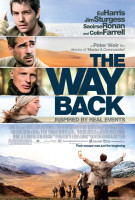The Way Back Filming Locations
The Way Back Filming Locations
Vakarel is a village, 41 km away from Sofia, the capital of Bulgaria. Population: 1984 people. It is situated in the Sredna Gora mountains, within Ihtiman Municipality. The village is an important transport knot along the Sofia - Plovdiv railway route. The Trakiya motorway runs near Vakarel.
Morocco, a North African country bordering the Atlantic Ocean and Mediterranean Sea, is distinguished by its Berber, Arabian and European cultural influences. Marrakesh’s medina, a mazelike medieval quarter, offers entertainment in its Djemaa el-Fna square and souks (marketplaces) selling ceramics, jewelry and metal lanterns. The capital Rabat’s Kasbah of the Udayas is a 12th-century royal fort overlooking the water.
Erfoud is an oasis town in the Sahara Desert, in the Drâa-Tafilalet region, eastern Morocco. It belongs to ait atta tribe, divided into several districts: Hay Salam, Hay Jdid, Hay Ziz, Hay el Bathaa, Hay Annahda, and Hay el Hamri.
Darjeeling is a town in India's West Bengal state, in the Himalayan foothills. Once a summer resort for the British Raj elite, it remains the terminus of the narrow-gauge Darjeeling Himalayan Railway, or “Toy Train,” completed in 1881. It's famed for the distinctive black tea grown on plantations that dot its surrounding slopes. Its backdrop is Mt. Kanchenjunga, among the world’s highest peaks.
Ouarzazate is a city south of Morocco’s High Atlas mountains, known as a gateway to the Sahara Desert. Its huge Taourirt Kasbah, home to a 19th-century palace, has views over the rugged local landscape, which features in several movies. Northwest is the fortified red-earth city of Aït Ben Haddou. Northeast is the rocky Todra Gorge. A road winds southeast through the Draa Valley’s lush palm groves to the desert.
Sofia is the capital of the Balkan nation of Bulgaria. It’s in the west of the country, below Vitosha Mountain. The city’s landmarks reflect more than 2,000 years of history, including Greek, Roman, Ottoman and Soviet occupation. Medieval Boyana Church has 13th-century frescoes. Built by the Romans in the 4th century, St. George Rotunda Church has medieval and Ottoman decoration dating to the 10th century.
Bulgaria is a Balkan nation with diverse terrain encompassing Black Sea coastline, a mountainous interior and rivers, including the Danube. A cultural melting pot with Greek, Slavic, Ottoman, and Persian influences, it has a rich heritage of traditional dance, music, costumes, and crafts. At the foot of domed Vitosha mountain is its capital city, Sofia, dating to the 5th century B.C.
The Way Back (2010)
Siberian gulag escapees travel four thousand miles by foot to freedom in India.
